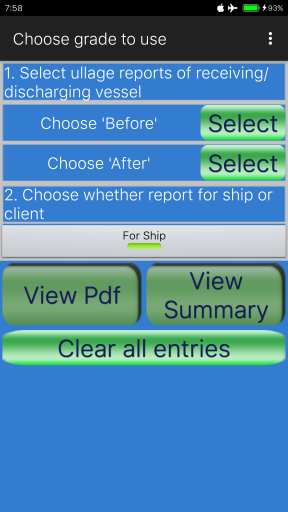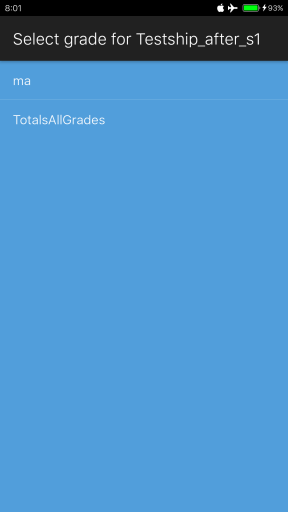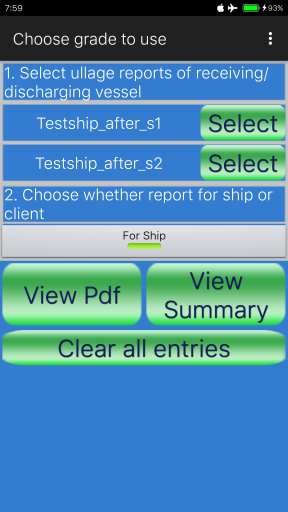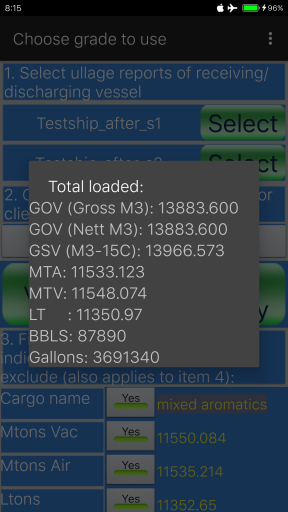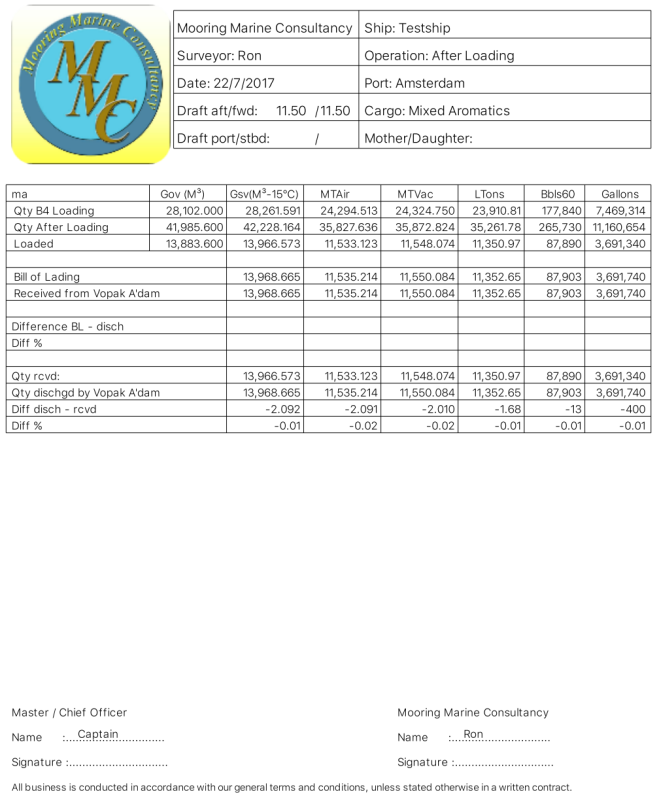The tutorials part 8 for the Android version of Cargo Surveyor deals with the Transfer executive summary report.
In number 7 of the tutorials for Cargo Surveyor for Android we discussed in part the sixth document of the set of documents required to be produced in the load port, the ullage report.
Today we will discuss part 8 of the tutorials, which will deal with the transfer executive summary report:
In the previous session concerning the ullage report we completed generating two ullage reports, and we discussed how to generate the ullage report, send it by mail and export it to csv.
Once a cargo operation is completed, we can use the transfer executive summary utility to:
- Calculate cargo discharged or loaded (in the case of part discharge, and in case of loading multiple parcels such as with our Testship)
- Calculate comparisons between ship received / shore supplied, or in case of STS operations mother / daughter discharged / received
- Calculate comparisons between Bill of lading figures and ship discharged, or Bill of lading figures and ship received
To get to the Transfer report editor we first need to go to the list of reports (‘Pdf/jpg Reports’), which can be accessed by pressing the options menu button (on newer phones this in the top right hand corner of the screen); this options menu is available from within:
- the first screen when you open the app
- the tank configuration screen for standard layout
- the tank configuration screen for extended layout
After pressing the option ‘Pdf/jpg Reports’, the list of available types of reports appears. If you accessed this from the very first screen, a message comes up first, asking you to confirm whether to use standard or extended layout for ullage reports. The choice between extended and standard layout is very important for ullage reports and transfer summary reports, because depending on which layout you select you will only be able to select ullage reports that have the chosen layout:
After selecting ‘EXTENDED’ or ‘STANDARD’ (if asked to choose), from the list above you select ‘Transfer report’, and this will bring you to the Transfer report editor:
When selecting ‘Transfer Report’ in the reports screen, you will be presented with the transfer report editor immediately. Inside this editor you can select the two ullage reports to use for producing the transfer report. When you press ‘Select’ next to the ‘Choose Before’ label, the list with available ullage reports will appear. You can select the one you want to use, choose whether you want to use the totals of all grades or one particular grade, and after that the name of that ullage report appears instead of the ‘Choose Before label’. The same goes for the ‘Choose After’ selection:
As you can see in the picture on the left side, our two earlier generated ullage reports have been selected: ‘Testship_after_s1’ and ‘Testship_after_s2’, and for each report the grade ‘ma’ has been selected. We could also have selected ‘TotalsAllGrades’ in this case since each report only contains one grade, but if the vessel were loading multiple grades then we would definitely have to select here the grade that we want to be calculated only.
You can also see that in step 2: Choose whether report for ship or client, the switch is set to ‘For Ship’. To produce the executive summary report we need to change it to ‘For Client’. After changing to ‘For Client’, a whole bunch of fields become visible where we can enter Bill of lading quantities and quantities loaded or discharged from / to terminal or other vessel.
If we leave the switch to the ‘For Ship’ setting, only the quantities before and after the operation are printed, and the total loaded or discharged quantity. No comparison is calculated between ship and shore or mother / daughter vessel, or ship / BL figures.
Below the ‘For Ship’ switch there are three buttons:
– View Summary: when pressed, this will show the total quantity loaded or discharged
– View Pdf: when pressed, this will generate the actual pdf (or jpg) file, and allow you to send by email, export to csv etc.
– Clear all entries: when pressed, this will clear all fields that show up when ‘For Client’ is selected. After selecting ‘For Client’ and entering data in the various quantity fields etc, all data entered there is stored in app settings, so that it is available the next time you opt to use the Transfer report. When you press the ‘Clear all entries’ button, all this data is cleared from the app settings.
Now let’s have a look at the full view of the transfer report editor when ‘For Client’ is selected:
Item 3 under the buttons ‘View Pdf’ and ‘View Summary’ allows you to enter any Bill of Lading details. It also lets you select which units will be printed in the transfer summary report, using the switches ‘Yes’/’No’ behind each unit.
There are switches for mtons vac/air, ltons, M³ at 15°C and M³ at 60°F, Bbls and Gallons. In case the vessel is doing an STS transfer, there are two switches for applying VEF.
Item 4 under these switches lets you select whether the cargo operation is at a shore terminal or doing ship to ship. If you select ‘Terminal’, the switches for VEF are set to ‘No’ and disabled, as shown in the picture.
Under the ‘Terminal’ switch you can enter details of the quantity loaded or discharged from / to terminal or other vessel.
As you can see we have entered here quantities both for Bill of Lading and for quantity supplied by the terminal. Whether we use M³ at 15°C or M³ at 60°F depends on whether we have selected SI Metric or Imperial in general settings: in Europe you generally use SI Metric and consequently M³ at 15°C; in the US or other countries where Imperial units are adopted you use M³ at 60°F. The two switches for M³ at 15°C and 60°F cancel each other out: if you select ‘Yes’ for M³ at 15°C, the switch for M³ at 60°F is automatically set to ‘No’ and vice versa.
After filling in the required quantities and other details we can now press ‘View Pdf’ and the pdf report will be generated, as shown below. The report has been printed using SI Metric units in general settings.
If you wanted to print the report in Imperial units, then you should also select M³ at 60°F for the GSV Bbls under item 3 and item 4 and instead of M³ at 15°C, otherwise GSV quantities will not match.
Just like the other reports, once we generate the pdf or jpg file, we get the option to send the report by email, export the report to csv, and email the csv, as discussed in the previous tutorials.
This ends the tutorial no.8. In the next tutorial we will discuss the sampling report.
In the mean time, for those who are interested in Cargo Surveyor for Android: the app can be downloaded here:
We post updates for the app in Google Play frequently to solve minor bugs, and advise all users to update as soon as a new update is available; we don’t use advertisements in Cargo Surveyor and we never will.
If you have any queries, suggestions, comments, criticism about the app or this blog post, please let us know! We always do our best to accommodate any requests for additions/modifications to our apps if they improve the value!





